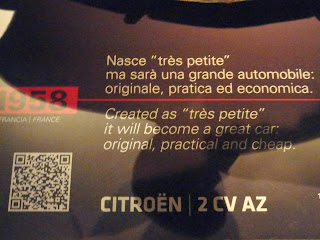Mike gave up trying to sleep at 6:00 AM and went out for a walk where he enjoyed watching the vendors setting up their awnings for the weekly market. I gave up trying to sleep at 6:30 so we were both out early walking through the giant weekly junk market that moves up and down the coast, stopping at a different town every day.
Walking along the Lungomare Vittorio Veneto we passed the bandstand, the Chiosco della Banda Cittadina, with its beautifully frescoed ceiling. It was built in 1929 with money donated by locals who had emigrated to Chile.
The most striking feature on the seafront is Rapallo's miniature castle. it was built in 1551 to defend the town from pirates. It was used as a prison until the 20th century and is now an exhibition center.
It was finally 10:00 AM and time to catch the first ferry to Santa Margherita Ligure just 15 minutes up the coast from Rapallo. As we were sitting on the ferry waiting for it to leave, we watched two large tour groups board and head to the top deck even though it was kind of windy and cool, clomping up the stairs in perfect pairs which is how they march everywhere.
As the ferry pulled out, I was able to get a good picture of beautiful Rapallo from the water with a solid line of flea market vans along the Lungomare!
After a short but scenic ferry ride up the coast, we pulled into Santa Margherita Ligure. In 1850 residents set to work creating a Riviera resort. They imported palm trees from North Africa and paved a fine beach promenade. Santa Margherita was studded with fancy villas built by the aristocracy of Genoa and the English, Russian and German aristocrats also discovered the town in the 19th century.
After a much needed stop for cappuccino, tea and a tart, we went to the Oratory of Sant'Erasmo, a small church named for St. Erasmus (a.k.a. St. Elmo), the protector of sailors. The first thing we saw was the typical local black-and-white pebble mosaic (riseu) in front of the church with maritime themes. The church is actually an "oratory", where a brotherhood of faithful men who did anonymous good deeds congregated and worshipped. It's decorated with ships and paintings of storms that -- thanks to St. Erasmus -- the local seafarers survived.
We then walked up a loooong stairway to reach the Church of San Giacomo. Even though this is a secondary church, it is impressively lavish with inlaid marble floors and sparkling glass chandeliers.
Next door to the Church of San Giacomo is Durazzo Park. This part was an abandoned shambles until 1973 when the city took it over. The garden has two distinct parts: the carefully coiffed Italian garden (designed to complement the villa's architecture) and the calculatedly wild "English garden" below. The Italian garden in famous for its varied collection of palm trees and an extensive collection of camellias.
It is okay to feed the large turtles in the central pond (they like bits of fish or meat) and we were sad we didn't have anything to give them, but we did enjoy watching them vie for the perfect place in the sun!
The beautiful Villa Durazzo was the home of a local journalist and writer and is a museum of his furniture and keepsakes and has another local black-and-white pebble mosaic out front.
Down the hill in the center of town is the main church, the Basilica of Santa Margherita, with a textbook Italian Baroque 18th-century façade.
The Via Palestro is a promenade (a.k.a.
caruggio -- "the big street" in local dialect) and is
the street for window-shopping, people-watching and studying the characteristic Art Nouveau house painting from about 1900. Before 1900, people distinguished their buildings with pastel paint and distinctive door and window frames. Then they decided to get fancy and paint entire exteriors with false balconies, weapons, saints and beautiful women.
We found a restaurant at the harbor for a lunch of salad nicoise for Mike and minestrone Genovase for me. We had planned on taking the ferry to Portofino after lunch, but while we were eating we watched several ferries come by, all loaded with tour groups headed to Portofino. We had been to Portofino, a beautiful but very small town, on a previous trip and had memories of a peaceful time there and decided to not ruin that memory on this day!
Since the ferries were all so full of tour groups, we walked to the train station and caught the train for the 10 minute ride back to Rapallo. We went to the grocery store and stopped at a café on the Lungomare for some gelato and wine and beer before heading back to the hotel to relax.
We went back to the Hostaria Vecchia Rapallo where we split an insalata mista and each had the pansotti al sugo di noce (a fresh pasta filled with herbs and greens and topped with walnut cream sauce -- an amazing local specialty and not to be missed) with a very nice white blend wine from Portofino.























































